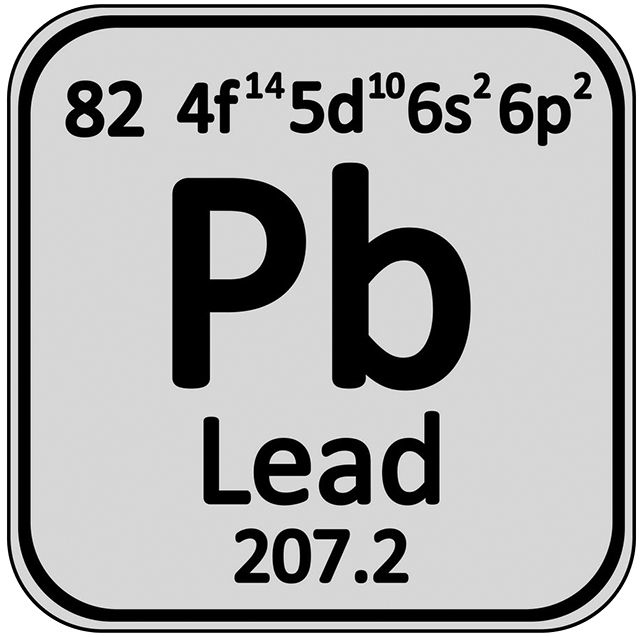Element number 82—lead—has been known to humankind for millennia and is one of the seven metals of antiquity, the others being gold, silver, copper, iron, mercury and tin. For thousands of years till the present age, lead has been used for myriad purposes.
The main reason for its widespread use even in ancient times was that its melting point (327.5°C) was much lower than most metals, making it that much easier to separate it from its ores. Another reason was that the metal was durable and malleable and appeared to be resistant to corrosion, much like modern plastic. The metal was so flexible, it could be transformed into thin sheets and soldered into pipes. As the lead mining historian Lynn Willis put it, lead could be considered to be the plastic of the past.
A long history of manifold uses
Lead artefacts can be found throughout the ancient world. The Romans were among the first to use lead on an industrial scale. Throughout the Roman Empire, lead was used for lining aqueducts and making water pipes. In fact, their Latin name for lead—plumbum—was from where the chemical symbol for lead, Pb, and the English words ‘plumber’ and ‘plumbing’ were derived. The Romans also used lead for making tablets for recording inscriptions, coins, cooking utensils, and for making decorative paints and a sweetener-cum-preservative for wines.
Lead’s association with the construction trade too goes back a long way. It has been providing waterproof material for roofing and window frames, and also for sealing stone walls, for long. Masons used to formerly use a heavy lump of lead on a string as a plumb-line. Lead carbonate has been used for making cheap, durable paint since ancient times.
As late as in the 17th century, most of the well-to-do people in western countries had lead tableware, water pipes and tanks, and drainage pipes.
Even today, lead is used in multiple fields from the automobile and marine industries to the medical field as a protection against radiations, X-rays and the sports field for making equipment like corrosion-resistant scuba diving weight belts. After World War I, the demand for lead rose greatly because of a higher production of cars and motorised vehicles, a large number of which used lead-acid batteries for starting their engines.
Lead is rarely found in the free state in nature. Galena (PbS) is the primary ore of the metal, other important ores being anglesite (PbSO4) and cerussite (PbCO3).
By the early 21st century, the highest producers of lead in concentrate.in the world included China, Australia, the US, Mexico, Peru, and India.

Advantageous properties
Lead is a heavy metal that is soft and malleable and is a poor conductor of electricity. Silvery white when freshly cut, it gets tarnished in moist air and develops a grey-coloured coating that was earlier thought to be lead suboxide (Pb2O). Now, we know the coating formed is a mixture of lead and lead monoxide (PbO) that protects the metal from further corrosion.
It is because of this property of corrosion-resistance that lead has numerous industrial and chemical applications.
Lead may be soluble in dilute nitric acid, but it is widely used for storing corrosive chemicals like sulphuric acid or hydrochloric acid. It is only superficially attacked by such strong acids because of the protective coating of insoluble lead sulphate or chloride that forms on its exposed surface, thus preventing a continued reaction with the acids. This property of chemical resistance makes it a metal of choice for roofing, coverings for electric cables placed underground or underwater, linings of water pipes and conduits, and structures used for transporting or processing corrosive substances.
Also, molten lead is an excellent solvent for silver and gold. Other useful properties of elemental lead are its ductility, low melting point, high density, and the ease of welding it. The metal’s ability to absorb gamma rays and X-rays is the reason why we find it in doctor’s clinics and X-ray rooms and as a protective shield around nuclear reactors and containers used for moving and storing radioactive materials.
From among the many applications of lead, the most extensive one is in the manufacture of storage batteries. Lead is a principal component of lead-acid batteries used in cars. It is also used for making ammunition (bullets).
Lead poisoning
One of the negative properties of lead is its low tensile strength that limits its structural applications. However, a more serious one is that lead and its compounds are toxic to human life and other life forms. Their continued retention and accumulation in the body over a period of time leads to what is known as cumulative poisoning. The more soluble the lead compound, the higher its toxicity.

Lead poisoning even has a special name—saturnism. The connection of the name to the planet Saturn could be because alchemists used to associate lead with Saturn, the Roman god of agriculture and harvest. They used Saturn’s symbol, the sickle—a harvesting implement—to represent lead.
The toxicity of lead has been known from ancient times. Vitruvius, the renowned Roman engineer and architect from the time of Julius Caesar wrote that “water is much more wholesome from earthenware pipes than from lead pipes”. Sometime later, in the first century A.D, the Greek physician and pharmacologist and author of the famed De Materia Medica had noted the harmful effects of lead on the mind. Despite that, lead continued to be widely used by the Romans in several products such as paints, cosmetics, and water pipes.
But, the greatest source of lead poisoning could have been the wine they drank. The Romans boiled unfermented grape juice in lead kettles to form a concentrate called sapa for sweetening and preserving their wines. What they didn’t know was that the aromatic syrup contained around 1 gm per litre of lead. Not surprisingly, lead poisoning was a disease of the wealthy in ancient Rome.
Today, we know that chronic lead exposure causes headaches, depression, aggression, memory loss, and even sterility. It is believed that the world-famous painters Caravaggio, Francisco Goya, and Vincent Van Gogh, all three of whom suffered from mental problems, could have had lead poisoning because of overexposure to or careless handling of oil paints containing lead while painting. In those days, white colour oil paint was made with lead carbonate.
In the 20th century, there was a marked increase worldwide in lead exposure levels due to the growing use of lead. For instance, the most wide spread toxic addition to the global environment is believed to be the additive tetraethyl lead (TEL) in gasoline from the 1920s onwards. For seven to eight decades, millions of vehicles dispersed this toxic substance into the environment all over the world. Lead is also added to the ubiquitous polyvinyl chloride (PVC).
Recent positive developments
In the 1970s and 1980s, the American paediatric psychiatrist Herbert Needleman discovered that even extremely low levels of lead exposure caused irreversible damage to infants and unborn babies. Their IQs tended to drop as they grew older, they struggled to concentrate on studies, and often dropped out of school. Needleman’s discovery is responsible for lead finally getting taken out of gasoline in the US and gradually in other parts of the world. Now, paints and insecticides containing lead are being phased out and the movement to eliminate lead from the environment continues.
However, the most prominent use of lead today is in cars. Around 90% of the lead produced is used to make batteries, mostly car batteries. Even hybrid and fully electric cars have a lead acid battery to complement the main lithium or metal-hydride battery in the car.
The good news is that unlike containers of leaded petrol, a lead-acid battery is a sealed unit from which the lead never escapes. Also, lead has the highest recycling rate of any metal. Around half of all refined lead today comes from recycled batteries and lead-containing scrap. The recycling rate of lead batteries in Europe and North America is almost 99%! And that’s not only due to strict enforcement of environmental regulations. It’s just that lead is a metal that’s absolutely easy to recycle.
References
1. Traci Pedersen: Facts About Lead – Live Science, 6 October, 2016, https://www.livescience.com/39304-facts-about-lead.html
2. Somobrata Acharya: Lead between the lines – Nature Chemistry, Volume 5, Page 894, 23 September, 2013
3. Royal Society of Chemistry: Lead –http://www.rsc.org/periodic-table/element/82/lead
4. Anne Marie Helmenstine: 10 Lead Element Facts – Thought Co., 20 September, 2018, https://www.thoughtco.com/lead-element-facts-608167
5. Geology.com: Uses of Lead – https://geology.com/usgs/lead/
6. Dr. Herbert L. Needleman: History of lead poisoning in the world – BiologicalDiversity.org, https://www.biologicaldiversity.org/campaigns/get_the_lead_out/pdfs/health/Needleman_1999.pdf
7. Laurence Knight: The fatal attraction of lead – BBC News Magazine, 12 October, 2014, https://www.bbc.com/news/magazine-29568505.
































